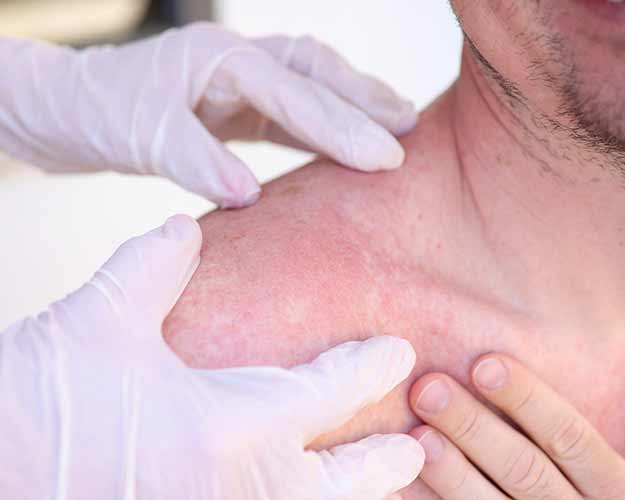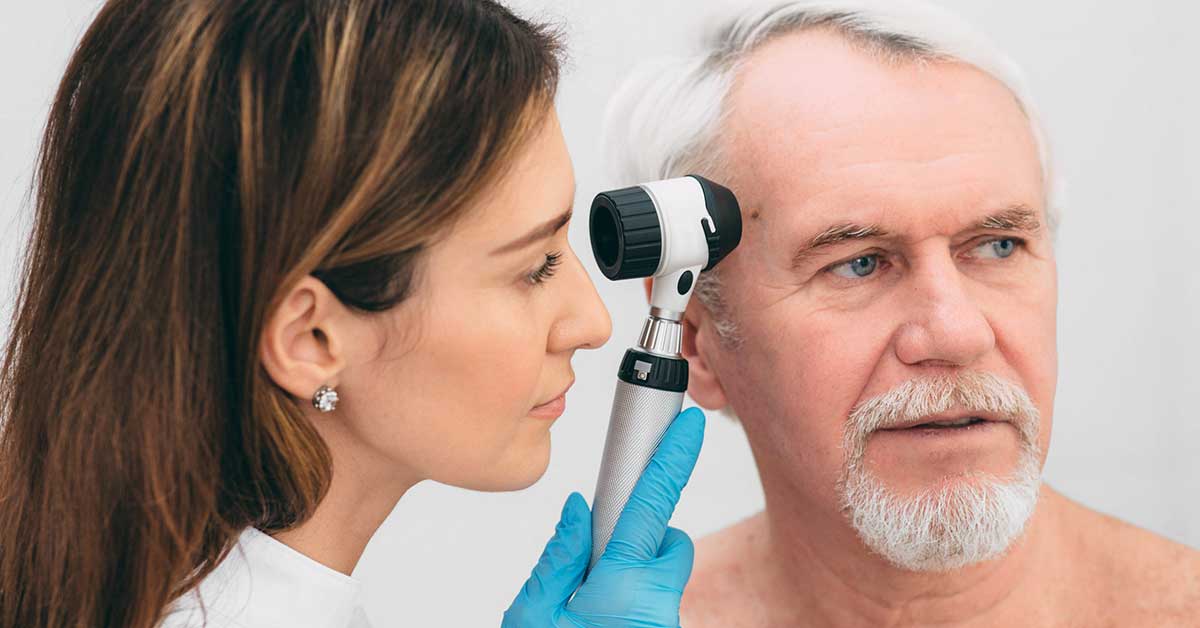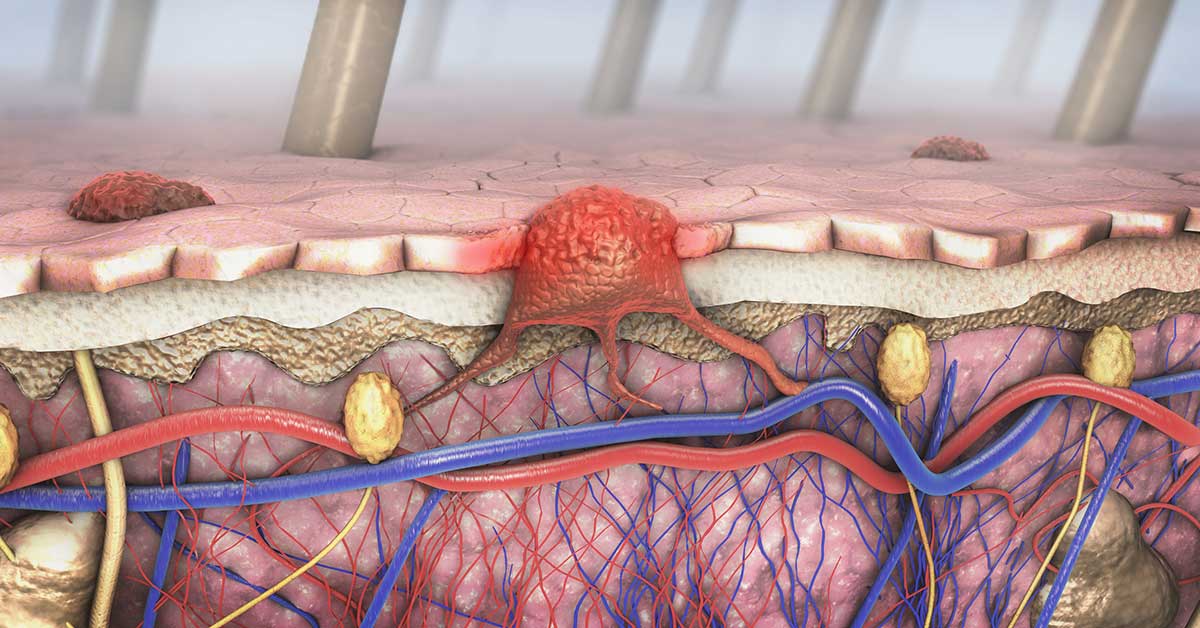Merkel Cell Carcinoma - Skin Cancer
Contact Us
What is Merkel cell carcinoma?
Merkel cell carcinoma is a rare type of skin cancer that appears most often on the face, head or neck, but can develop anywhere on the body. Merkel cell carcinoma is sometimes called neuroendocrine carcinoma of the skin.
Merkel cells are found at the base of the outermost layer of the skin, known as the epidermis, and connected to the nerve endings that enable the sense of touch. First identified by Friedrich Merkel in 1875, these cells were originally described as touch cells due to their close association with nerve fibers. Cancer occurs when these cells begin to grow out of control.
What are the signs and symptoms of Merkel cell carcinoma?
Merkel cell tumors often look like firm bumps or nodules on the skin. They can be skin-colored or shades of red, pink or blue and are usually not painful. Merkel cell tumors are fast-growing and often spread (metastasize) as new lumps on the skin or to lymph nodes or other organs, which makes it one of the most dangerous skin cancers.
Back to Top
How is Merkel cell carcinoma diagnosed?
Diagnosing Merkel cell carcinoma begins with a physical examination so that your doctor can evaluate the symptoms you are experiencing. Your doctor may also feel for bumps on nearby lymph nodes, which can indicate that the cancer has spread. Other types of testing and imaging scans may be necessary to make a definitive diagnosis.
Additional information to confirm a diagnosis and how advanced the disease is can be obtained through more in depth examination of the skin. The doctor may perform a skin biopsy to remove all or part of the affected area(s) for examination under a microscope to look for any precancerous or cancerous cells. Sometimes a biopsy will remove all or part of the tumor.
What causes Merkel cell carcinoma?
The exact cause of Merkel cell carcinoma is not known. Repeated and unprotected exposure to ultraviolet (UV) rays can damage skin cells and lead to skin cancers. UV rays occur naturally in sunlight, as well as from man-made sources such as tanning beds. Without adequate protection, UV rays can damage the DNA inside skin cells and cause changes in how these cells function. An infection caused by the Merkel cell polyomavirus (MCV), a common virus that lives on the skin, is found in many tumors and appears to play a role. Researchers are continuing to learn more.
Is Merkel cell carcinoma genetic?
While Merkel cell carcinoma does not appear to run in families, multiple genetic factors and pathways may contribute to increased risk. It is best to talk with your doctor regarding any genetic predisposition to these cancers.
Back to Top
Is Merkel cell carcinoma curable?
Merkel cell skin cancers are frequently curable when found and treated in early stages, but they can recur (come back) even after successful treatment. Treatment success can vary, especially when the cancer has spread. Anyone diagnosed with any type of skin cancer is at higher risk of developing skin cancers in the future, so it is important to continue watching for warning signs.
Back to Top
How is Merkel cell carcinoma treated at FCS?
Each patient and each cancer is unique. At FCS, physicians develop a personalized treatment plan in partnership with patients. Treatment options depend on a number of factors, including the specific type and stage of cancer, possible side effects, and the patient’s overall health and personal preference. Surgery to remove the cancerous cells and healthy tissues surrounding them is the most common treatment for Merkel cell carcinoma. Other treatments can include radiation therapy and chemotherapy to shrink or kill tumors. Immunotherapies that engage a person’s own immune system to find and destroy cancer cells is a promising treatment option for Merkel cell carcinoma, especially at later stages of disease.
Back to Top
What are common risk factors for Merkel cell carcinoma?
Prolonged exposure to UV rays, either from the sun or from artificial sources, greatly increases the risk of skin cancer. Daily use of sunscreen with a sun protection factor (SPF) of 30+ applied to all exposed areas of the body can greatly reduce risk. Use of tanning beds should also be avoided.
The risk of developing Merkel cell carcinoma increases with age. The majority of people (75%) diagnosed are over age 65; the average age at diagnosis is 74. Men are slightly more likely to develop Merkel cell carcinoma. People with weakened immune systems caused by blood cancers, HIV/AIDS, autoimmune diseases or organ transplants are at significantly higher risk of developing Merkel cell skin cancers.
Are there screening tests for Merkel cell carcinoma?
Skin cancers are cancers that we can see and feel. Monthly self-exams and annual skin checks by a dermatologist are vital to early detection. Spots, blemishes, freckles and moles are signs of sun-damaged skin. They are usually harmless, but if you notice them changing or if something doesn’t look or feel right, it is important to reach out to your medical doctor or dermatologist.
Back to Top
















